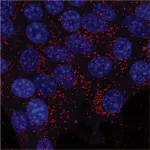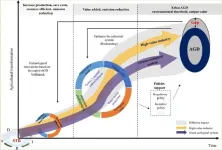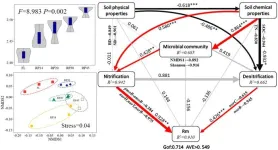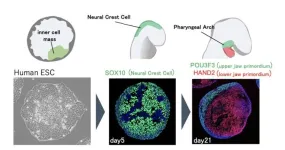(Press-News.org) Softer tumours fuel more aggressive spread of triple-negative breast cancer
Researchers have discovered how the mechanical properties of tumours can prime cancer cells to better survive their spread to other organs.
A metabolic ‘survival switch’ controlled by the stiffness of triple-negative breast tumours can significantly influence how successfully their cancerous cells spread to other organs, according to new findings from the Garvan Institute of Medical Research.
The study in cell and mouse models showed that softer tumour environments, typical of early-stage cancer, can prime triple-negative breast cancer cells to use an extra energy source for survival during metastasis. The research suggests that drugs targeting this altered cancer cell metabolism could boost treatments for metastatic triple-negative breast cancer.
“Our research suggests triple-negative breast cancer cells in soft tissue environments are ‘primed’ to better survive the spread to other organs and that they switch on an alternative form of metabolism to do so,” says Associate Professor Cox, Head of the Matrix & Metastasis Lab at Garvan and senior author of the study published in Advanced Science.
“This suggests that triple-negative breast cancer cells spreading from softer tumours are more aggressive, and drugs that target cancer cell metabolism may benefit patients with metastatic triple-negative breast cancer treatment.”
A metabolic survival advantage
Triple-negative breast cancers are highly aggressive and difficult to treat as they lack three receptors (for oestrogen, progesterone and the HER2 protein) that can be targeted in other breast cancers. New treatment options are urgently needed for the 2,500 women diagnosed every year in Australia alone.
Using biomaterials that mimic the properties of tumours, the team investigated how triple-negative breast cancer cells respond to the physical stiffness of their environment. The researchers found the cancer cells were primed to be more resilient when grown in soft environments and, when injected into mouse models, up to 11.8 times more likely to metastasise to new sites compared to those from rigid tumour environments.
The team also discovered that soft environments altered the cancer cells’ preference for ‘fuel’ in a way that enhanced their durability while travelling through the body. These primed cells metabolised glucose – the preferred energy source for cancer cells – but they also stockpiled lipids as internal fuel reserves and in turn ramp up lipid metabolism – a more resilient energy pathway for their journey from a primary tumour site.
“This switch to using both glucose and fats as an energy source equips cells to better survive the mechanical stresses of travelling through the blood stream and seeding new tumour sites throughout the body,” says first author Dr Elysse Filipe, who completed the study as a postdoctoral researcher at Garvan. “By blocking lipid metabolism in triple-negative breast cancer cells, we were able to ‘starve’ their high energy demand and reduce metastasis in a cell model.”
A new approach for triple-negative breast cancer
“Our findings highlight that the physical properties of triple-negative breast cancers, which vary dynamically as the cancer progresses, profoundly impact the cancer’s ability to spread,” says Dr Filipe. “These findings reveal a vulnerability of triple-negative breast cancers – the metastasising cells’ reliance on diverse fuel sources to meet their high energy demands.”
Associate Professor Cox adds: “The study underscores the importance of considering the mechanical diversity within and between tumours when designing new treatments for aggressive cancers. We now plan to explore whether pairing targeted metabolic inhibitors with existing therapies could limit metastasis and improve outcomes for triple-negative breast cancer patients.”
--ENDS--
This research was supported by Australia’s National Health and Medical Research Council, Cancer Council NSW and an Australian Government Research Training Program Scholarship.
Associate Professor Cox is a Conjoint Associate Professor at St Vincent's Clinical School, Faculty of Medicine and Health, UNSW Sydney.
END
Softer tumours fuel more aggressive spread of triple-negative breast cancer
Researchers have discovered how the mechanical properties of tumours can prime cancer cells to better survive their spread to other organs.
2024-04-12
ELSE PRESS RELEASES FROM THIS DATE:
Dynamic-EC: An efficient dynamic erasure coding method for permissioned blockchain systems
2024-04-12
It's interesting to hear about the research led by Minyi Guo that was published in Frontiers of Computer Science on 12 Mar 2024. It seems like they are addressing the challenge of reducing storage overhead in blockchain systems while maintaining data consistency and tolerating malicious nodes.
In traditional blockchain networks, full replication is used, where each node stores a complete copy of all blocks, and data consistency is maintained through a consensus protocol. However, this approach can be storage-intensive, especially as the blockchain grows over time.
To address ...
How does the STB promote the coordination between environmental protection and agricultural development in Erhai Lake?
2024-04-12
Erhai Lake, covering 252 km2, located in Yunnan Province, is one of the seven largest freshwater lakes in China. However, over the last three decades, the lake has suffered pollution episodes. In order to solve this problem, the local government has taken many protective measures. These measures have achieved some results in the environmental protection of Erhai Lake, but also caused significant socioeconomic impact. The tension between environmental preservation and economic stability in Erhai has even been termed the ‘Erhai dilemma’. The ‘Erhai dilemma’ is representative of those of other lakes in Yunnan Province ...
New study uncovers the role of soil microbes in forest ecosystems
2024-04-12
Assessing the function of forest ecosystems requires a deep understanding of the mechanisms of soil nitrogen mineralization. A recent study conducted by a team of researchers has shed light on how soil N-cycling genes drive soil nitrogen mineralization during afforestation. The findings, published in the prestigious journal Soil Ecology Letters, provide valuable insights into the relationship between soil microbial communities, functional genes, and the rate of soil nitrogen mineralization.
The researchers collected soil samples from a chronosequence of Robinia pseudoacacia L (RP14, RP20, RP30, and RP45) at different stages of afforestation, along with a sloped farmland (FL) as ...
Cells putting on a face
2024-04-12
Kyoto, Japan -- Mother Nature is an artist, but her craft of creating animal faces requires more than a paintbrush and palette. Such highly complex shapes originate from their respective transient neural crest cells.
These embryonic pluripotent cells within the facial primordium—the early development form—may be necessary for forming proper facial structures. However, analyzing the molecular mechanisms in such early stages of development poses many technical challenges.
Now, a group of Kyoto University researchers have produced neural crest cell-rich ...
First clinical trial of vosoritide for children with hypochondroplasia shows increased growth
2024-04-12
WASHINGTON (April 11, 2024) – Vosoritide’s first global phase 2 study showed an average increased growth rate of 1.8 cm per year in children with hypochondroplasia, a genetic cause of short stature in children, according to researchers from Children’s National Hospital.
“This is the first medicine that has been developed to specifically target the pathway involved in hypochondroplasia,” says Andrew Dauber, M.D., chief of Endocrinology at Children’s National. “These findings will help inform future studies of vosoritide for addressing growth disorders.”
This clinical trial ...
Two key brain systems are central to psychosis, Stanford Medicine-led study finds
2024-04-12
Inside the brains of people with psychosis, two key systems are malfunctioning: a "filter" that directs attention toward important external events and internal thoughts, and a "predictor" composed of pathways that anticipate rewards.
Dysfunction of these systems makes it difficult to know what’s real, manifesting as hallucinations and delusions.
The findings come from a Stanford Medicine-led study, publishing April 11 in Molecular Psychiatry, that used brain scan data from children, teens and young adults with psychosis. The results confirm ...
Rice’s Megan Reiter wins NSF CAREER Award to investigate planet-forming environments
2024-04-12
Megan Reiter, an assistant professor of physics and astronomy at Rice University, has won a National Science Foundation (NSF) CAREER Award to investigate the influence of neighboring stars on the formation of planets.
The research funded by Reiter’s five-year, $951,446 NSF grant will shed light on a phenomenon that could significantly impact our understanding of how planets are born.
“By exploring the intricate interplay between stars, planets and their environments, we hope to clarify the key forces that shape planet formation,” Reiter said.
Observations show planets form in the ...
ISSCR hosts free Earth Day webinar “Stem Cells for Species Conservation”
2024-04-12
Join the International Society of Stem Cell Research (ISSCR) to celebrate Earth Day on 22 April 2024 by diving into the science of conservation, where the potential of stem cells is harnessed to foster a more sustainable and biodiverse future. This enlightening webinar co-hosted by Ashlee Hutchinson and Jun Wu will spotlight the revolutionary intersection of induced pluripotent stem cells (iPSCs), embryo models and genome engineering technologies with the noble cause of species preservation.
As our planet faces unprecedented biodiversity loss, this program will unveil how cutting-edge scientific advancements offer a lifeline for endangered species, ...
University of Oklahoma engineer receives $3.1M grant for clean hydrogen technologies
2024-04-12
NORMAN, OKLA. – Hanping Ding, Ph.D., an assistant professor in the School of Aerospace and Mechanical Engineering at the University of Oklahoma, has been awarded a $3.1 million grant from the Hydrogen and Fuel Cell Technologies Office in the Department of Energy through the Bipartisan Infrastructure Law to further research in clean hydrogen production. The funding is part of a $750 million effort in President Biden’s Investing in American agenda. The money from the Department of Energy will go to 52 projects across 24 states to position the United States as a global leader in the clean hydrogen industry.
The combined outcomes of the 52 projects should allow the ...
Prestigious European grant for research into biodegradable plastics
2024-04-12
Professor dr. Linda Amaral-Zettler, Research Leader at NIOZ Royal Netherlands Institute of Sea Research and the Chair in Marine Microbiology at the University of Amsterdam has been awarded a prestigious Advanced ERC-grant by the European Commission today. Amaral-Zettler receives almost 3,5 million euros for her research into biodegradation in the marine environment. “Biodegradable sounds really nice”, she admits. “But before we repeat the mistakes we’ve made with fossil-fuel-based plastics back in the last millenium, we really want to understand how these materials interact with marine life and how long they last in the environment.” “Biodegradable ...
LAST 30 PRESS RELEASES:
Global psychiatry mourns Professor Dan Stein, visionary who transformed mental health science across Africa and beyond
KIST develops eco-friendly palladium recovery technology to safeguard resource security
Statins significantly reduce mortality risk for adults with diabetes, regardless of cardiovascular risk
Brain immune cells may drive more damage in females than males with Alzheimer’s
Evidence-based recommendations empower clinicians to manage epilepsy in pregnancy
Fungus turns bark beetles’ defenses against them
There are new antivirals being tested for herpesviruses. Scientists now know how they work
CDI scientist, colleagues author review of global burden of fungus Candida auris
How does stroke influence speech comprehension?
B cells transiently unlock their plasticity, risking lymphoma development
Advanced AI dodel predicts spoken language outcomes in deaf children after cochlear implants
Multimodal imaging-based cerebral blood flow prediction model development in simulated microgravity
Accelerated streaming subgraph matching framework is faster, more robust, and scalable
Gestational diabetes rose every year in the US since 2016
OHSU researchers find breast cancer drug boosts leukemia treatment
Fear and medical misinformation regarding risk of progression or recurrence among patients with breast cancer
Glucagonlike peptide-1 receptor agonists and asthma risk in adolescents with obesity
Reviving dormant immunity: Millimeter waves reprogram the immunosuppressive microenvironment to potentiate immunotherapy without obvious side effects
Safety decision-making for autonomous vehicles integrating passenger physiological states by fNIRS
Fires could emit more air pollution than previously estimated
A new way to map how cells choose their fate
Numbers in our sights affect how we perceive space
SIMJ announces global collaborative book project in commemoration of its 75th anniversary
Air pollution exposure and birth weight
Obstructive sleep apnea risk and mental health conditions among older adults
How talking slows eye movements behind the wheel
The Ceramic Society of Japan’s Oxoate Ceramics Research Association launches new international book project
Heart-brain connection: international study reveals the role of the vagus nerve in keeping the heart young
Researchers identify Rb1 as a predictive biomarker for a new therapeutic strategy in some breast cancers
Survey reveals ethical gaps slowing AI adoption in pediatric surgery
[Press-News.org] Softer tumours fuel more aggressive spread of triple-negative breast cancerResearchers have discovered how the mechanical properties of tumours can prime cancer cells to better survive their spread to other organs.










